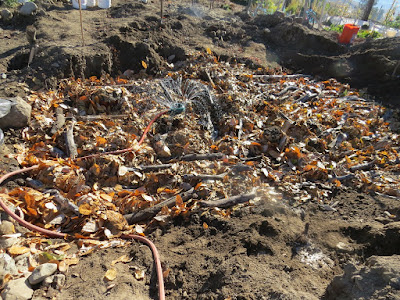Looking back on the construction of my subterranean hotbeds, this is one that hasn't been covered on the blog yet.
I decided to make one bed with a diverse mix of species -- spruce, alder, aspen, whatever I could find. Depending on the piece, it was laid either vertically or horizontally, making it a truly "mixed" bed.
"Before"
This bed was built during the second year of hugel-construction in the garden. The green areas on the right are one-year-old rotting wood beds, growing prolifically. The bare soil at left-center includes the place where the mixed bed went in.
"Before"
The soil was so dense before building the subterranean beds, that it felt like walking on a high traffic hiking trail. Our farmer friend Bill remarked on the sensation underfoot, saying that it felt like hard pan, with no give. Now it is fluffy with earth worm castings and plenty of aeration as the wood settles and breaks down.
I put manure on the top of every exposed vertical end, to provide nitrogen at those important interfaces. The logs were surrounded by horse manure, with longer pieces in layers with the manure.
Next, I added lots more wood, filling some of the gaps with large and small pieces.
Another load of horse manure helped turn this into a hotbed. Thorough watering after every layer helps trap moisture inside the bed. This is the one and only chance to directly water these surfaces, so it's important not to take shortcuts in applying water during construction.
And leaves! Lots and lots of leaves...
A little soil, more leaves, and more water.
As I built up closer to the surface, I added smaller diameter wood in a bed of leaves. The experiment here is to see how it works planting into the smaller diameter wood as compared with the large pieces. Also, being smaller, they have greater surface area and will break down quicker -- similar to the smaller food pieces in your compost pile.
This close up of one of the vertical pieces helps you to visualize how accessible the wood tissues would be for roots to penetrate, as compared with the side of a log. This is the rationale behind placing pieces vertically. However, that said, my horizontal beds are performing just as well in general, so the orientation has not proven critical in the Wood for Food garden. The amount of manure and rotting straw seems to be a more important factor (the more the merrier).
"After"
















No comments:
Post a Comment
Thank you for commenting on the Wood for Food blog! Your feedback is much appreciated. :-)